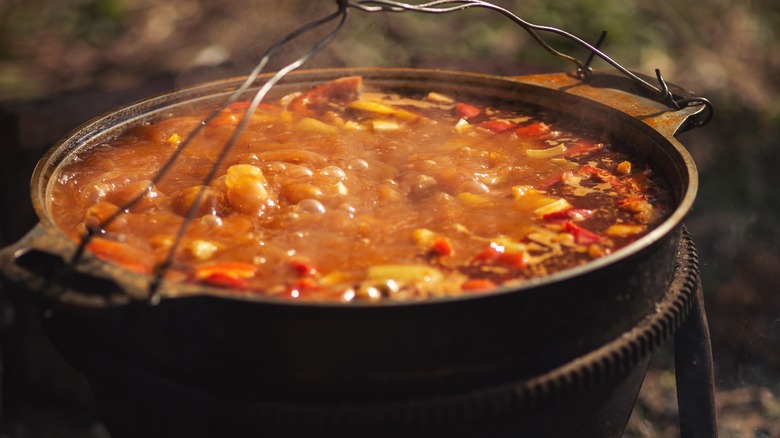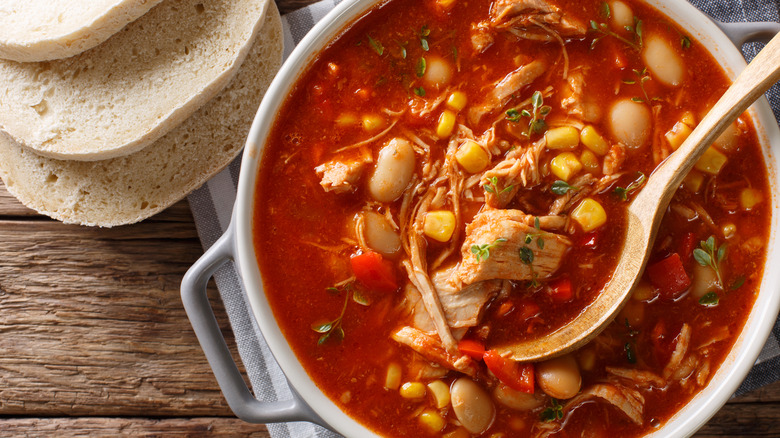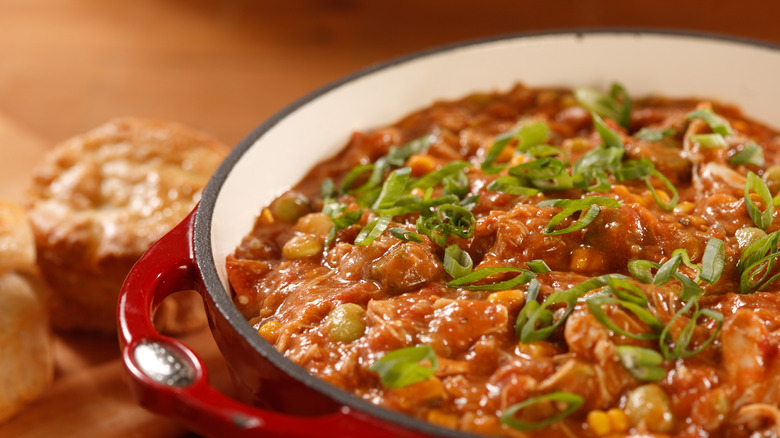How Camp Stew Became A Traditional Side Dish At Alabama Barbecues
Southern cuisine has an abundance of incredible history that adds to its decadence. From biscuit's Scottish origins to jambalaya's fusion of African, Caribbean, and French cuisines, there are dozens of dishes that feature extensive backstories. One of the best examples of this might be camp stew, a mixture of meat (traditionally including hog's head), tomatoes, potatoes, onions, and lima beans. This popular recipe dates way back to the 19th century and has remained one of Alabama's signature side dishes.
Camp stew was first documented in 1883 by a Wisconsin journalist covering a barbecue in Montgomery, Alabama. While its exact creator and the origins of its name remain unknown, some speculate that this dish got its name due to how easy it is to whip up outdoors. Unlike other regional stews of the time, this dish originally served as a side that used up the remaining cuts of a pork roast at the end of hog season. We can surmise that the star of dinner would be the beautifully roasted meat, but that rich stew, featuring the leftover cuts and offal, would make a hearty side to stretch the meal even further.
By the beginning of the 20th century, camp stew became so popular that restaurants, churches, and even jails began to serve it alongside leading barbecue entrees like pulled pork and fried catfish. Today, some barbecue joints in Alabama continue to sell it as a side, and there are many variations of this recipe available to try at home.
Camp stew's contents set it apart from other recipes
Often, stews are made by browning protein with flour before submerging everything in the cooking liquid. The opposite rings true for Alabama's signature side dish, which sometimes places every ingredient in the pan concurrently and sometimes just boils the meat to make the rich broth before the veg is added. While this seems counterintuitive at first glance (after all, searing enhances flavor), keep in mind that this camp stew uses canned goods or leftover roast to make in a jiff. This side also usually features a combination of pork, chicken, and often beef — another thing that sets it apart from standard stews, which typically utilize a singular cut of meat.
Camp stew's bold mixture of meat and beans might lead some people to compare it to chili, another classic side dish that also uses a variety of protein. Both recipes are thick and utilize tomatoes to give their broth some tang. The similarities don't end there, as some camp stews omit beans just as many chili recipes do too. When the Alabaman recipe uses legumes, they are usually lima beans — not kidney or pinto.
Another thing that sets camp stew apart is how effortlessly it can be whipped up at home. You can cut its cooking time considerably by either using canned goods or opting for a pressure cooker, making it an excellent weeknight dinner choice.
Tips for making camp stew at home
While camp stews were originally designed as a way to finish up less desirable cuts of pork, that doesn't mean you can't use quality cuts of meat in your own recipe. If you're using a slow cooker to make this classic Alabama side, take the time to find the best inexpensive cuts of protein at the grocery store. Pork tenderloin, chicken thighs, and beef bottom rounds are excellent choices, as they can withstand prolonged simmering without turning dry or completely falling apart.
To give your camp stew a splash of sweetness, a dash of ketchup may be mixed in conjunction with the tomatoes. Worcestershire is a necessity, and hot sauce can also be a great addition, depending on whether you prefer your food to taste more savory or spicy.
Lastly, while camp stew can be enjoyed by itself or with barbecued meat, you'll want to pair it alongside a spongy bread to mop up the sauce in your bowl. Many people like to serve this dish with cornbread (which, traditionally, has no sugar in it), but a crusty loaf can also work. Historically, it might be served at Church functions alongside chicken salad sandwiches, so don't hesitate to consume it with lighter recipes as well. And if you ever find yourself roasting a whole hog at a barbecue, remember — this stew is a great way to use up less desirable cuts, so nothing goes to waste.



